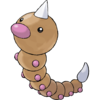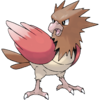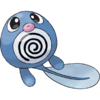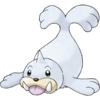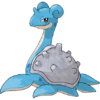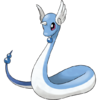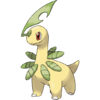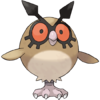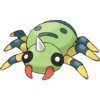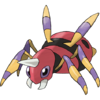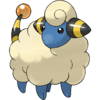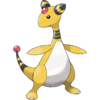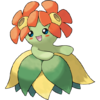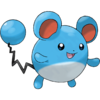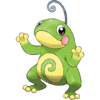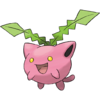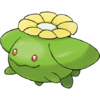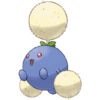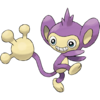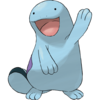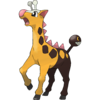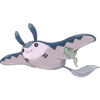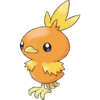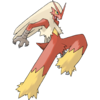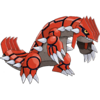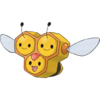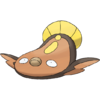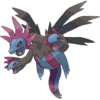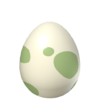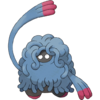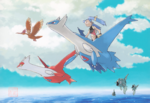List of unused Pokémon and character designs
These are Pokémon and characters that were just a few of many different designs that Game Freak created. Only a few were added, and even those often went through redesigns before making it into the final product. Additionally, some Pokémon had early designs that were changed or altered by the time of their release.
A few creatures that bear a striking resemblance to certain Pokémon appear in Volume 14 of Bimonthly Game Review (Japanese: 隔月刊ゲーム批評) magazine, though these are stated to not be Pokémon. Nonetheless, some of their designs may have been reworked into Pokémon later.
Altered Pokémon
| Pokémon | Description |
|---|---|
| Generation I | |
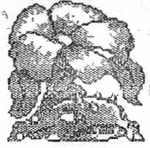 Venusaur |
This early design shows Venusaur, though with Ivysaur's final index number and name, フシギソウ. Though, this is indeed Venusaur, as this is also the case with Cloyster from this period which uses Shellder's final index number and name. It maintains a blossomed flower on its back. |
 Karabajio and Mimī |
In this early depiction of a battle, Blastoise is shown without its signature water cannons, and Staryu has a slightly different design. This picture is captioned "Karabajio VS. Mimī", which are not the names of any known Pokémon. Karabajio may be a reference to the Italian painter Caravaggio, which in turn may reference how the Teenage Mutant Ninja Turtles are named after Italian artists. It also may include "carapace". |
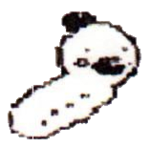 Kokana |
An early version of Weedle. This was one of several Pokémon sprites shown on Game Freak's official Japanese website circa 1997. |
 Kasanagi |
The evolution of Kokana. This was one of several Pokémon sprites shown on Game Freak's official Japanese website circa 1997. It was replaced by Kakuna, although they share few similarities. |
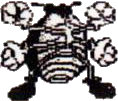 Kasanagi evolution |
The evolution of Kasanagi. This was one of several Pokémon sprites shown on Game Freak's official Japanese website circa 1997, labelled "undecided". Like its pre-evolution, it was replaced by Beedrill, but it somewhat resembles Ledian and a cockroach. |
 Spearow |
This early version of Spearow, identified by its index number, was revealed on a sprite sheet for Pokémon Red and Green. Its design is different, with traits similar to both Farfetch'd and its final version. |
| Pikachu |
In an interview with Japanese newspaper Yomiuri on May 2, 2018, Pikachu's original illustrator, Atsuko Nishida, revealed the Pokémon's initial prototype resembled a daifuku (a round dessert) with ears.[1][2][3] Its design basis changed to a squirrel to make it cuter overall, although the black tips on its ears are remnants of the initial concept. |
 Clefairy |
An early design for Clefairy, identified by its index number, that was shown on a sprite sheet for Pokemon Red and Green. Its round body is similar to its final design, although there are many differences, such as its horns and extremely enlarged eyes. |
 Poliwag |
An early version of Poliwag. This was one of several Pokémon sprites shown on Game Freak's official Japanese website circa 1997. |
 Nyosuka |
An early version of an evolved form for Poliwag. This was one of several Pokémon sprites shown on Game Freak's official Japanese website circa 1997. Notably it is wearing a crown, similar to the King's Rock necessary to evolve Poliwhirl into Politoed. |
 Seel |
A very early design for Seel, revealed in the 2018 educational manga "Satoshi Tajiri: The Man Who Created Pokémon". It was again part of the Popularity Poll entry sheets shown in the manga on a board. Although it does not resemble its final design, its name in Japanese, Pauwau (パウワウ'), is identical. |
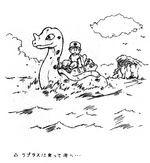 Lapras |
This early version of Lapras is recognizably similar, but visually quite different. Lapras's curly ears are not present, and the underbelly coloration ends under the lower jaw instead of including it. There are also no visible appendages or tail, but that may be due to the water. However, it bears a striking resemblance to its Generation I back sprite. Also in the sketch is an early design of Red. |
 Dragonair |
An early version of Dragonair. This was one of several Pokémon sprites shown on Game Freak's official Japanese website circa 1997. |
| Generation II | |
 Hanamogura |
Chikorita's prototype evolution, present in the Spaceworld '97 demo, looked drastically different from the final Bayleef, with an appearance resembling a blossom. Its name in the demo was (Japanese: ハナモグラ Hanamogura). The final design, released a couple of years later in 1999, can be seen below. |
 Hōhō |
An early design of Hoothoot, present in the Spaceworld '97 demo, had facial markings resembling freckles and a tail acting as a single, pendulum-like feather. Its name in the demo was (Japanese: Hōhō). The final design, released a couple of years later in 1999, can be seen below. |
 Bobo |
An early design of Noctowl, with a design more reminiscent of Hoothoot, was present in the Spaceworld '97 demo. Its name in the demo was (Japanese: ボーボー Bobo). The final design, released a couple of years later in 1999, can be seen below. |
 File:Spr b 2d 185.png File:Spr b 2d 185.pngKokumo |
An early design of Spinarak with segmented legs was present in the Spaceworld '97 demo. Its name in the demo was (Japanese: コクモ Kokumo). The final design, released a couple of years later in 1999, can be seen below. |
 File:Spr b 2d 186.png File:Spr b 2d 186.pngTwohead |
An early design of Ariados that strongly resembles Spinarak and has a face on its abdomen, was present in the Spaceworld '97 demo. Its name in the demo was (Japanese: ツーヘッド Twohead). The final design, released a couple of years later in 1999, can be seen below. |
 Pachime |
An early design of Mareep was present in the Spaceworld '97 demo. Its name in the demo was (Japanese: パチメエ Pachime). The final design, released a couple of years later in 1999, can be seen below. |
Ampharos |
An early sprite of Ampharos from when Pokémon Gold and Silver were in development for the original Game Boy, as shown by its two-tone color palette. Ampharos is shown with a shorter neck and it only has two rings around its neck instead of three. |
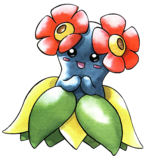 Bellossom |
The artwork of Bellossom used until Pokémon FireRed and LeafGreen shows that it was originally to be a similar color to its other evolutionary relatives. This might have been changed to avoid another racial controversy, as the original Bellossom design appears similar to traditional Polynesian dress. |
 File:Spr b 2d 179.png File:Spr b 2d 179.pngMariru |
An early design of Marill was present in the Spaceworld '97 demo. While it is recognizably similar, it has several visual differences, most notably the pink color. It also does not sport Marill's erratic tail pattern. Its name in the demo was (Japanese: Mariru). The final design, released a couple of years later in 1999, can be seen below. |
 File:Spr b 2d 199.png File:Spr b 2d 199.pngNyorotono |
A drastically different early design of Politoed with a more frog-like appearance, no antenna, and the swirling pattern seen on the rest of the Poliwag line, was present in the Spaceworld '97 demo. Its name in the demo was (Japanese: Nyorotono). The final design, released a couple of years later in 1999, can be seen below. |
 File:Spr b 2d 214.png File:Spr b 2d 214.pngHaneko |
An early, darker version of Hoppip present in the Spaceworld '97 demo, lacked limbs and had a long tail. Its name in the demo was (Japanese: ハネコ Haneko). The final design, released a couple of years later in 1999, can be seen below. |
 File:Spr b 2d 215.png File:Spr b 2d 215.pngPoponeko |
An early design of Skiploom with no limbs and a long tail was present in the Spaceworld '97 demo. Its name in the demo was (Japanese: ポポネコ Poponeko). The final design, released a couple of years later in 1999, can be seen below. |
 File:Spr b 2d 216.png File:Spr b 2d 216.pngWataneko |
An early design of Jumpluff with no limbs and a long tail resembling a hot air balloon was present in the Spaceworld '97 demo. Its name in the demo was (Japanese: ワタネコ Wataneko). The final design, released a couple of years later in 1999, can be seen below. |
 File:Spr b 2d 250.png File:Spr b 2d 250.pngTail |
A drastically different design of Aipom, closer in design to a lemur, was present in the Spaceworld '97 demo. Its name in the demo was (Japanese: テイル Tail). The final design, released a couple years later in 1999, can be seen below. |
 File:Spr b 2d 175.png File:Spr b 2d 175.pngMizuuo |
An early design of Quagsire, with a chubbier body, no dorsal ridge, and a tail resembling Poliwag's, was present in the Spaceworld '97 demo. Its name in the demo was (Japanese: ミズウオ Mizuuo). The final design, released a couple of years later in 1999, can be seen below. |
 File:Spr b 2d 194.png File:Spr b 2d 194.pngKirinriki |
This sprite of Girafarig from the Spaceworld 1997 demo shows the original design featured two full-sized giraffe heads. It is unknown why the design was changed, but overall it remains mostly similar outside of some coloring differences. This design might be a reference to Girafarig's name being a palindrome. It also bears a resemblance to a pushmi-pullyu. Its name in the demo was (Japanese: Kirinriki). The final design, released a couple of years later in 1999, can be seen below. |
 Haneei |
This sprite of Mantine from the Spaceworld 1997 demo shows the original design featured a feathered bird-like design. Besides the feathers, the face on the back of Mantine's original design is much more prominent and intimidating, as opposed to the design of Matine, which simply has two circles that give off the allusion of eyes. Its name in the demo was (Japanese: ハネエイ Haneei). The final design, released a couple of years later in 1999, can be seen below. |
| Generation III | |
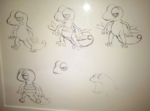 Treecko |
Concept art of Treecko shows numerous designs for the creature before the final one was decided. Many of these early sketches more closely resemble real geckos than the final product, which would later gain a more elongated head shape and a rounder nose. |
  Torchic |
This early version of Torchic shows its lower body covered by an eggshell, with the fluff going all around its neck and wing-shaped ears. The other early design is nearly identical to the current Torchic, aside from the large floppy ears, and a flame-shaped marking on the back of its head, rather than the final design's flame-shaped feathers on top of its head. |
 Blaziken |
A design of Blaziken that featured wings.[4] Sometimes referred to as Latiken or Latiaziken by fans, this early image from Pokémon Ruby and Sapphire also features many traits shared by Latias and Latios. |
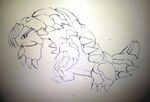 Groudon |
In its early design, its eyes were shaped differently, the positioning of the spikes on its body was slightly different, its overall shapes are much less sharp, its head details became much more elongated in the final version, and the Super-Ancient Pokemon's signature body patterns are not present. |
| Generation IV | |
 Combee |
The original design for Combee featured three larvae, instead of honey bees, wedged inside a honeycomb. Ken Sugimori noted that while the concept sounded "gross", it is nonetheless a distinctive and attention-grabbing idea, so the team decided to keep the design and tweak it slightly. In particular, Combee's three faces were simplified, based on simple faces found in old comic books, to make its overall appearance friendlier.[5] |
  Shellos and Gastrodon |
Prototype back sprites of Shellos and Gastrodon found in the release versions of Diamond and Pearl show another form for each. These forms are possibly leftovers from when Shellos and Gastrodon were planned to be in Generation III. Shellos's sprite is pink, like its West Sea form, and seems to combine the West Sea form's head with the East Sea form's body. Gastrodon's sprite is brown and looks like its West Sea form, but with more rock-like protrusions on its body. |
| Generation V | |
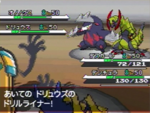 Excadrill |
In Excadrill's first appearance in a promotional video, its body was violet and its markings were mirrored and a different shade of red. However, it was changed to its current appearance in the next video it appeared in. |
| Throh and Sawk |
According to interviews with Ken Sugimori in Nintendo Dream, during development, Sawk and Throh both had horns to look more like oni. However, these were replaced with eyebrows so as not to clash with Tornadus and Thundurus, who were originally designed to be red and blue, like Throh and Sawk.[6] |
| Stunfisk |
Stunfisk's design was originally based on a goosefish, but eventually became more like a flounder. It was also a Water/Electric-type, but was changed to Ground/Electric to balance out the type spread of Pokémon.[7] |
| Deino, Zweilous, and Hydreigon |
Hydreigon's evolutionary line was originally designed with a tank motif, with the tread-like markings on Zweilous and Hydreigon being remnants of this design. The initial designs were scrapped after the designers felt that it didn't work. Later, a powerful, three stage Dragon-type evolution was needed and the design was brought back and revised.[6] Hydreigon's design was based on the eight-headed Yamata no Orochi, although it is designed with fewer heads to appear less off-putting.[6] |
| Tornadus and Thundurus |
Initially, Tornadus and Thundurus were designed as red and blue demons. However, the designers felt that the colors made them too similar to Sawk and Throh, so the horns of Sawk and Throh were replaced with eyebrows.[6] |
Unreleased Pokémon
Capsule Monsters designs
| Pokémon | Description |
|---|---|
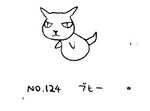 Buhī |
Nothing is known about this cat-like creature other than its number, #124, the same as Jynx. This number is also the index number of Metapod. |
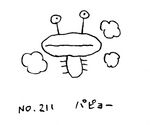 Papyō |
Nothing is known about this bug-like creature other than its number, #211, the same as Qwilfish. |
 Oviparous creature |
In the artwork featuring an early version of Red and Gyaōn inside a cave, an unidentified creature can be seen. It appears to be hatching from an Egg. |
 Godzillante and Gorillaimo |
Nothing is known about Godzillante. It is shown to be breathing fire. As its name implies, it may have been based on Godzilla. Godzillante shares a resemblance to a fake Pokémon toy shown in the Pokémon Pocket Monsters manga Volume 1 (p. 107). Its placeholder number is #23 as shown in the storyboard where it comes from.
Nothing is known about Gorillaimo. Its hat could be a reference to the character Ninten from the Ape Inc. game, Mother. It also resembles the Nintendo character Donkey Kong. Gorillaimo could also be based on King Kong. Later generations have introduced many ape-based Pokémon. |
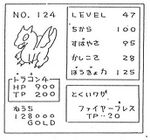 Dragon4 |
Dragon4 (Japanese: ドラゴン4) has the number #124 (coincidentally the same as Buhī). It knows a move called "Fire Breath" (Japanese: ファイアーブレス) that requires 70 TP.[8]
It has short arms, a long tail, two horns on the back of its head, and draconic wings. It bears some resemblance to an early version of Scyther,[9] as well as Charizard. |
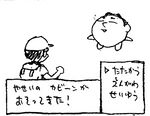 Kabīn |
Not much is known about this creature, though it appears to be an early design for Snorlax. It has a roughly humanoid head, but with a round body shape. Its name, Kabīn, is similar to Kabigon, Snorlax's Japanese name. It also has similarly shaped eyes and it somewhat resembles a simplified caricature of Kōji Nishino. Its appearance and name is also similar to the video game character Kirby (Nishino's nickname, and Snorlax's Japanese namesake[10]). |
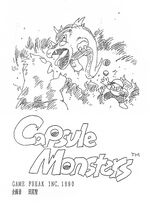 Unknown creatures |
An early drawing of a creature resembling Gengar and a creature with traits of Nidorino, Gyarados, and Feraligatr. |
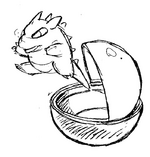 Unnamed kaiju-esque creature |
Not much is known about this Pokémon. It was shown being released from a Monster Capsule. It seems to have features of a Rhydon, shrunken down to fit into the ball. |
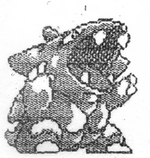 Gyaōn |
This unused Generation I Pokémon was revealed in an episode of NHK featuring the Capsule Monsters pitch booklet. It looks like a Tyrannosaurus Rex. Nothing else is known about this Pokémon. Interestingly, its index number is "1" while Rhydon's is "0". |
Pokémon designs
| Pokémon | Description |
|---|---|
| Generation I | |
| Gorochu | Gorochu (Japanese: ゴロチュウ Gorochū) was originally intended to be Raichu's evolution. Pikachu's original illustrator, Atsuko Nishida, and Pokémon designer Ken Sugimori revealed the lost evolution in an interview with Japanese newspaper Yomiuri on May 2, 2018.[1][2][11] The design was to include fangs and a pair of horns. Sugimori cited game balance issues, which led to the design being omitted from the games.
In April 2020, a leaked copy of the source code and assets for Pokémon Blue was released on the Internet. The source code was found to contain a collection of pre-release material detailing the development of Generation I. Among this information was a back sprite for a Pokémon matching Gorochu's description. |
 Deer |
An unused Generation I Pokémon design, revealed in the 2018 educational manga "Satoshi Tajiri: The Man Who Created Pokémon". It was shown on a page discussing a poll in which the staff of the game would vote for their favorite Pokémon before including some of them in the final games. It appears to be based on a deer. Its index number is "56". |
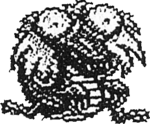 Crocky |
An unused Generation I Pokémon design, revealed in the 2018 educational manga "Satoshi Tajiri: The Man Who Created Pokémon". It was shown on a page discussing a poll in which the staff of the game would vote for their favorite Pokémon before including some of them in the final games. It appears to be based on a crocodile with large eyes and what appears to be long 'hair'. Its index number is "62". |
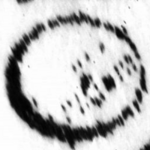 Balloonda |
An unused Generation I Pokémon design, revealed in the 2018 educational manga "Satoshi Tajiri: The Man Who Created Pokémon". It was shown on a page discussing a poll in which the staff of the game would vote for their favorite Pokémon before including some of them in the final games. It appears to be based on a balloon and its name is a pun on the word balloon. It may have also caused the split between Flying and Bird type. It may have inspired the design of Jigglypuff or Drifloon. |
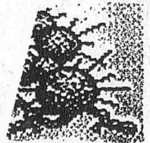 Cactus |
An unused Generation I Pokémon design, revealed in the 2018 educational manga "Satoshi Tajiri: The Man Who Created Pokémon", inspired by cacti. It was shown on a page discussing a poll in which the staff of the game would vote for their favorite Pokémon before including some of them in the final games. Its index number is "67". Its cry is still in the final game, left unused. The Pokémon series would eventually have it's first Cactus Pokémon in the form of Cacnea, which may have been redesigned with this unused Pokémon used as a basis. |
 Jagg |
An unused Generation I Pokémon design, revealed in the 2018 educational manga "Satoshi Tajiri: The Man Who Created Pokémon". It was shown on a page discussing a poll in which the staff of the game would vote for their favorite Pokémon before including some of them in the final games. It appears to be based on a shark, in particular those with a pointed head. Its index number is "68". |
 Unknown elephant |
An unused Generation I Pokémon design, revealed in the 2018 educational manga "Satoshi Tajiri: The Man Who Created Pokémon". It was shown on a page discussing a poll in which the staff of the game would vote for their favorite Pokémon before including some of them in the final games. It appears to be based on an elephant. Its index number is most likely "61" as it is behind Crocky. Its name, while obscured in the manga, appears to end in "ro" or "ko". |
| Kotora's evolutionary family | In April 2020, a leaked copy of the source code and assets for Pokémon Blue was released on the Internet. The source code was found to contain a collection of pre-release material detailing the development of Generation I. Among this information were back sprites for three cut tiger-like Pokémon which appear to have been part of the same evolutionary line. However, these Pokémon all lack any evolution data.
An unused Generation I Pokémon design, these designs would see an additional chance at existence during the production of Generation II. The first two stages of the abandoned three-stage evolutionary line were found present in the Spaceworld '97 demo. In the demo, the first two stages took the names of Kotora (Japanese:コトラ Kotora) and Raitora (Japanese:ライトラ Raitora), respectively. |
| Generation II | |
 Honōguma |
The original Fire-type first partner Pokémon present in the Spaceworld '97 demo. Its name is a combination of 炎 honō (flame) and 熊 kuma (bear). It knew the moves Ember, Scratch, and Leer. |
 Volbear |
The first evolution of Honoguma, present in the Spaceworld '97 demo. Its hair and tail are flaming. |
 Dynabear |
The final evolution of Honoguma, present in the Spaceworld '97 demo. It has long, flaming fur and strongly resembles Arcanine. |
 Kurusu |
The original Water-type first partner Pokémon present in the Pokémon Gold and Silver demo that was playable at Space World 1997. It knew the moves Growl, Water Gun, and Tackle. |
 Aqua |
The first evolution of Kurusu, present in the Spaceworld '97 demo. It has a horn on its head and a pearl on its neck reminiscent of Dragonair's. |
 Aquaria |
The final evolution of Kurusu, present in the Spaceworld '97 demo. It resembles a plesiosaur and, like Aqua, has a gem on its neck. |
 Mikon |
A baby Pokémon related to Vulpix and Ninetales, present in the Spaceworld '97 demo. It has a reddish body like Vulpix and three tails, which it would gain three more after each evolutionary stage, fittingly. |
 Monja |
A baby Pokémon related to Tangela, present in the Spaceworld '97 demo. It has a small dark-colored body with a single visible eye. It's unknown if it would have has a second eye, as its short curly vines partially obscure its face. |
 Jaranra |
An evolution related to Tangela, present in the Spaceworld '97 demo. It has a small dark-colored body with a visible smiling mouth. It's unknown if it would have had eyes like Tangela, as its curly vines obscure its face. As an evolution of Tangela, this Pokémon may have served as a predecessor to Tangrowth. |
| Unnamed sheep | Nothing is known about this Pokémon, nor is there any artwork of it known to exist. Junichi Masuda and Ken Sugimori revealed in an interview with @Gamer magazine that there was a rejected Pokémon design based on the first cloned sheep, Dolly. They removed it after deeming it "too controversial" for Pokémon. Since Dolly was born almost eight months after the Japanese release of Pokémon Red and Green, it is likely that this Pokémon would have been intended for Generation II. It is possible that the rejected design was reworked into Mareep or Flaaffy. |
| Generation V | |
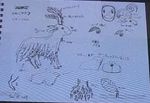 Nekkoyagi |
Before the release of Pokémon Black and White, concept art of this Pokémon, dated January 19, 2009, was exhibited during a festival at Meiji University from October 31 to November 1, 2010.[12] As noted in the concept art, Nekkoyagi (Japanese: ねっこやぎ) is a Grass/Ground-type, and has a pelt made out of roots. Its name is likely a combination of 根っ子 nekko (root) and やぎ yagi (goat). In an interview, it was said that Sawsbuck was created before the idea of seasons.[7]
Additionally, it is possible that some aspects of Nekkoyagi's design, such as its apparent goat inspiration and root pelt, were reworked as Gogoat. |
| Generation VI | |
| Unnamed rabbit | A Pokémon based upon a rabbit with a flower on its nose was designed by Hironobu Yoshida for Pokémon X and Y, but was scrapped due to it not making sense in its environment. It was revealed in an interview with Nintendo Life. |
| Mega Flygon | Flygon has had the potential to have a Mega Evolution since Pokémon X and Y, but Game Freak was unable to complete a design and so it was dropped from consideration. It was revealed in an interview conducted by the magazine Nintendo Dream. An English translation was provided by PokéBeach. |
Bimonthly Game Review
Volume 14 of the Bimonthly Game Review (Japanese: 隔月刊ゲーム批評) magazine, which was published on April 1997 by MicroDesign Publishing (Japanese: マイクロデザイン出版局), included an interview with Ken Sugimori. For this piece, Sugimori drew several original characters in the style of Pokémon, but not from the Pokémon world.[13]
| Pokémon | Description |
|---|---|
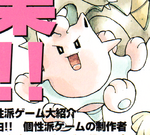 Unnamed creature |
This creature has an unusual appearance, sharing characteristics with both Clefairy and Hitmontop; in the case of the latter, a horned tail and multiple paws around its midsection suggest a similar top motif. However, this creature has its point located on its bottom, while Hitmontop has its point located atop its head. It's notable that at the time of the Spaceworld '97 demo, Hitmontop had a drastically different design that would not be finalized for a significant period of time. This in addition to the magazine's context, means it is unlikely to be related to the Tyrogue family. |
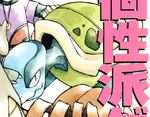 Unnamed turtle |
This creature does not resemble any Pokémon from Generation II, but does bear resemblance to Tirtouga from Generation V. |
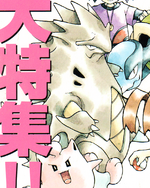 Tyranitar |
This creature strongly resembles Tyranitar, being extremely similar to the design seen in the finalized Gold and Silver versions. It has very few differences compared to the final version. Of these differences, the early Tyranitar design is more heavy-set, has a tan, rather than indigo belly, arms more reminiscent of Nidoking, and dozens of short spikes upon its back rather than a few long ones. However, at the time of the magazine's release, Tyranitar was not present in the Spaceworld '97 demo, and wouldn't appear in any revision for another two years. Thus, it is likely that this design, true to the interview in the magazine, was revisited and revised on its own merits. |
Unreleased characters
| Character | Description |
|---|---|
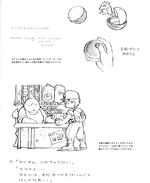 Shopkeeper |
Early Capsule Monsters artwork was shown in an episode of NHK featuring the Capsule Monsters pitch booklet, revealing an unnamed male character running a shop, or what would possibly become an early version of the Poké Mart. The character is almost bald, has long eyebrows and appears to be overweight. He is presented in a similar art style to the sumo enemies from Game Freak's debut title, Quinty (localized as Mendel Palace).
Revamped and enlarged versions of Mendel Palace's sumo sprites also appear in Ruby, Sapphire, and Emerald as unused overworld sprites. |
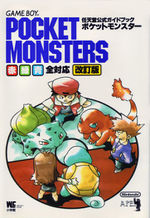 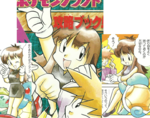 Female character |
This art of an unnamed female character (with Squirtle) was featured on the cover artwork for the official strategy guide for Red and Green, as published by Shogakukan. Sugimori had stated that he wanted to portray a trio of Trainers facing against each other, hence created the female character for the cover.[14] When Red and Green were being developed for a remake, Sugimori took the unnamed female character into consideration as he was designing the female player character, who later became known as Leaf.[15] A character named Green later appeared in Pokémon: Let's Go, Pikachu! and Let's Go, Eevee!, whose design appears to have taken inspiration from both the unnamed female character and the female player character of FireRed and LeafGreen. The unnamed female character also appeared several times in manga-styled instructions illustrated by Emiko Yoshino included in Pokémon papercraft sets (bottom). In the Pokémon Adventures manga, a similar artwork appeared at the end of Volume 3 (right). The design of the character Green seems to have drawn inspiration from this unknown female character. After the release of FireRed and LeafGreen, Green donned the same outfit as the female player character in the fifth chapter of the manga. |
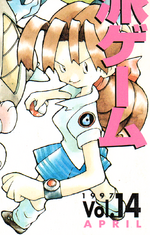 Female Trainer |
This unnamed female Trainer art was revealed in the cover of Volume 14 of MicroDesign Publishing's Bimonthly Game Review magazine, published prior to Generation II.[13] This was a design imagined by Ken Sugimori specifically for the magazine, created only to accompany the Games That Stand Out Collection feature. Visually, she has similarities to multiple Trainer classes. Her appearance is similar to a Beauty or Cool Trainer, but her outfit is similar to a Lass or Picnicker. There is an object on her shirt that looks like what could have been a Cascade Badge. |
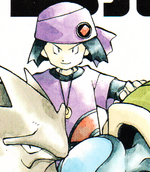 Male Trainer |
This unnamed male Trainer art was revealed in the cover of Volume 14 of MicroDesign Publishing's Bimonthly Game Review magazine, published prior to Generation II.[13] This was a design imagined by Ken Sugimori specifically for the magazine, created only to accompany the Games That Stand Out Collection feature. He has hints of multiple classes, such as a Tamer, Psychic, Juggler, Burglar, PokéManiac, Gambler and a male Rocket Executive. There is an object on his bandanna that looks like what could have been a Gym Badge. This Badge has a red diamond on it. |
 Female Trainer |
There is an unused Trainer seen riding Blaziken[4] in early concept art. It is difficult to tell whether she was intended to be a playable character, rival, or supporting character. This character has a strong resemblance to an unnamed character shown riding Latios in official artwork. |
See also
References
- ↑ 1.0 1.1 Pikachu Originally Had A Second Evolution Called ‘Gorochu’ With Large Fangs And Two Horns — SiliconEra
- ↑ 2.0 2.1 Creator Profile: The Creators of Pikachu - Pokemon.com (archived)
- ↑ Interview with Yomiuri about Pikachu's creation (page 1) (Japanese)
- ↑ 4.0 4.1 TCRF showcases that this was always originally Blaziken as opposed to Latios/Latias, who existed separately at one point.
- ↑ "What It Takes to Create a Pokémon." Interview with Ken Sugimori in Pokémon Ultra Sun & Pokémon Ultra Moon Edition: The Official National Pokédex, p. xvi-xvii
- ↑ 6.0 6.1 6.2 6.3 Nintendo Dream Vol. 205, May 2011 (Translation by Dr. Lava)
- ↑ 7.0 7.1 Nintendo Dream Vol. 204, April 2011 (Shellspider's blog (Japanese), Translation by Dr. Lava)
- ↑ https://helixchamber.com/media/capsule-monsters/capsulemonsters_03/capsule-monsters-battle-screens/
- ↑ Scyther identified by the Japanese name "ストライク" on the "NHK News: Ohayō Nippon" TV show, 19 December 2018 (screenshot)
- ↑ Shea, Brian (October 24, 2019). "More Burning Questions For The Pokémon Series." Game Informer (Archived on August 5, 2023.)
- ↑ Interview with Yomiuri about Pikachu's creation (page 3) (Japanese)
- ↑ Generation 5: Lost Pokemon Designs (Part 1) - Dr Lava #21 – YouTube
- ↑ 13.0 13.1 13.2 Bimonthly Game Review magazine, Vol. 14 (April 1997). MicroDesign Publishing. (transcript with English translations; Plague von Karma's scan with English translations and translator notes)
- ↑ Twitter - Sugimori on the origins of the unknown female character (Japanese)
- ↑ Twitter - Sugimori on designing the FRLG female protagonist (Japanese)



